Orchid cactus are beautiful houseplants that produce lovely flowers from early winter to the end of spring. Even though their name carries “orchid” and they’re in fact very similar to orchids, they’re not orchids.
I only included them in this website because so many people ask me if orchid cactus are orchids. Nope—they’re not. They’re cactus. Since their growing conditions are so similar to orchids, and they have flowers that are amazingly beautiful, they’ve earned the title orchid.
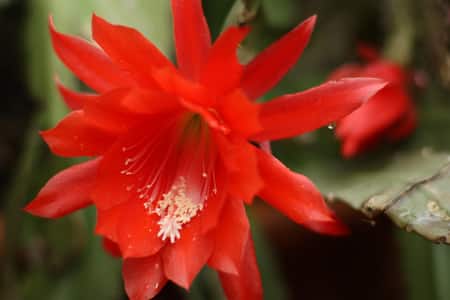
Their scientific name, Epiphyllum, has 19 different species, some which blossom only at night, others during the day.
This variation is due to the different pollinators that each species attracts. If the pollinators are night creatures, like moths, then the orchid cactus will blossom only at night and close in the morning. Unfortunately, most orchid cactus are night bloomers. If the orchid cactus species is one that attracts butterflies and bees, then it will open during the day. When you purchase an orchid cactus, make sure your species is a day blooming flower.
Orchid Cactus Care
If you follow the following guidelines in terms of light, temperature, fertilizer, and watering, orchid cactus are very easy to grow.
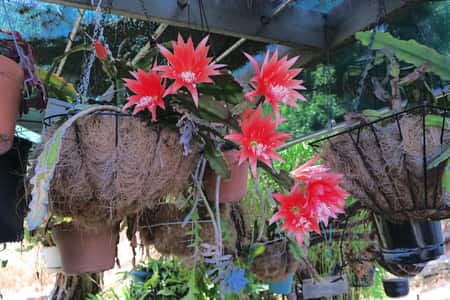
Light Requirements
Orchid Cactus prefer to be grown in bright light, but not direct sun during the hottest part of the day. Compared to orchids, they would be in the high-light category.
They can tolerate more sun than your Phalaenopsis (moth orchid) can, so these are perfect to grow by the window sill, or even outside when the weather permits.If you grow Vandas (in terms of light, not temperature) then wherever you place your Vanda orchid, the Orchid Cactus will also adapt well.
There are signs to know if your orchid cactus is getting too much sun or too little. If the leaves are turning a pale-yellow and wilting a bit, then it’s too much sun.
Temperature Requirements
Epiphyllums, or Epis for short, prefer temperatures that resemble a cooler indoor environment, which is why they are such good houseplants (65 to 75°F/18 to24°C). They also deal with the fluctuating temperature better, since the window sill will cause the temperatures to drop more drastically at night than other places in the house.
Even though orchid cacti can tolerate lower temperatures, don’t let the night temperature drop below 50ºF (10º C). This is the maximum they will tolerate. In nature, they grow from Central America all the way to the middle part of Brazil. It hardly ever drops below 50ºF in these countries.
In Mexico, there is a Orchid Cactus that has be renamed from Epiphyllums to Nopalxochia. This specific species tolerates higher temperatures during the day. The common name is the pond lily plant, which is a good description since these orchid cacti love water.
Humidity Requirements
This is where most people have problems with growing orchid cacti indoors. These plants prefer high-humidity, anything above 55%. They thrive at levels around 70%, but this is almost impossible without a greenhouse or an extremely powerful humidifier.
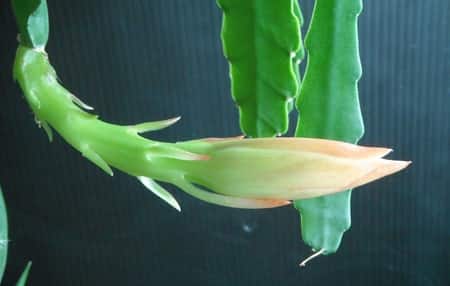
Pot, Vase, Terrarium: Where’s the Best Place to Plant an Orchid Cactu
Hanging baskets are perfect places of orchid cactus. The flowers grow form the very end or tip of the leaves, much like Christmas and Thanksgiving cacti. When in a hanging basket, the leaves cascade down, forming a gorgeous display.
Since orchid cactus can grow quite large, up to 2 feet, (60 cm) hanging baskets make an awesome display.
What Potting Medium do Orchid Cactus Grow in?
The great thing about orchid cactus is that if you already grow orchids, then you know everything that there is to know about growing orchid cactus. The care is exactly the same. Since Orchid Cacti are epiphytes (the grow on trees, attaching themselves to the bark) they don’t need or like organic potting soil.
To repot an Orchid cactus, you’ll nee to purchase orchid potting mix, or if they have it at your garden center, a specific Epiphyllum potting mix. If you prefer to make your own, you can use just 1 part an organic mix, like perlite, pebbles, or fir bark and 3 parts potting soil. Since they can live off leaf mold and prefer to always be a bit moister than orchids, add a little moss or sand (if you want) to your potting mix, too.

Orchid Cactus, just like orchids, need to be repotted every two years.
This is probably the most overlooked piece of information that home growers ignore. Since orchid cactus don’t use normal potting soil for their medium, they need to have a new medium to properly grow.
What is a Good Watering Schedule for Orchid Cactus?
Don’t be fooled by the name cactus and think that they don’t like water—orchid cacti love water. Contrary to most orchid groups, Cactus Orchids don’t like to dry out. Yet, if you overwater them, they’re doomed to fail.
Fine line…Fine line.
This is the hardest part about growing them: the balancing act between overwatering and drying out the roots.
Phalaenopsis, for example, like to have their roots dry out before watering again. This simulates the air currents in the tropical rainforest that evaporate any water in the aerial roots quickly.
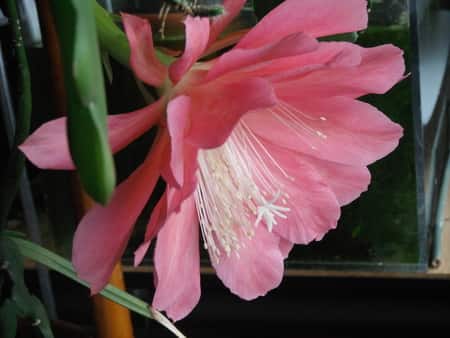
Orchid cactus grows in more humid climates, and prefers to always be a little on the moist side. Yet, too moist, the roots rot. You can leave them initially for 10 days without watering, which is a good period for testing.
Check to see if the top is humid and the bottom of the pot is dry.
Orchid Cactus Need a Dormancy Period
A time when you’ll not want to water them at all is when they go into dormancy for 8 to 10 weeks. After the cactus orchid has bloomed, and all the flowers have fallen off, the cactus will temporarily “shut down”. This means that it’s storing energy to start the new growth period, and needs time to recuperate.
During this dormant period, if you move your plant to a dark, cooler place, it will respond better. The best idea is to place it in the garage for a few weeks. Once the dormant period is over, you can bring them into a higher temperature room, with better lighting and restart the watering every ten days.
A good time to bring them back inside is early autumn.
This change in temperature signals to the orchid that it can start produce buds again, and new flowers start to develop.
How to Propagate Orchid Cactus?
Orchid cacti take a long time (around 5 years) to grow flowers if you plant them from the seeds. A quicker way to propagate the plant is to cut a thick leaf about 4 inches (10 cm), let it dry out a few days, and place it in the soil upside down about 1 or 2 inches, so it won’t fall over.
Don’t water it for a few days, just so it isn’t as prone to infection, and the leaf will produce new roots. Some growers advise to keep the cutting in a dark, cool place for up to 15 days, so the ends where it was cut can form a barrier. As succulents, orchid cactus don’t mind being out of a potting medium for such a long period. They won’t die.
Since this method is so easy, orchid cactus are perfect to give to friends who ask for a piece of your “orchid.” It’s also a great way to make bushy, full, extravagant plants with just a few beginner cuttings.
If you’re still worrying about shoving too many new growths into one pot, don’t be. In fact, the orchid cactus won’t bloom unless it is root-bound. That means that new buds won’t form until the roots are snug against one another.
This is the orchids way of gaining security. In nature, as it attaches to tree bark, it hangs on for dear life. The roots wrap tightly around the tree, securing it in place. It needs to feel the same, strong attachment to the side of the pot before it will grow new flower buds.
What Pests and Insects Bother Orchid Cactus?
Before I mention what bugs and insects attack the orchid cactus, the biggest problem after over watering is wind. Harsh, strong wind currents will rip the leaves in half, breaking them off and bend them so bad, they leave ugly markings.
If you take your orchid outside during spring and summer, make sure you hang it up in an area that is protected from wind currents.
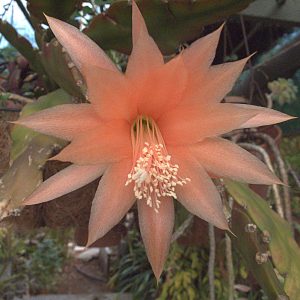
The number one “bug” that bothers orchid cacti are snails. That is another reason why hanging baskets are so perfect.
Snails are attracted to the moisture in the plants, near the base. The snails will climb up the leaves and munch on the tasty flower buds, and if not dealt with, they attract other inscets, like ants.Other pests that are a moisture-attracting problem are gnats and mealy bugs. There’s an extensive article about mealybugs here, if you want more information on why they attack orchids and how to get rid of them.
Don’t Stop Learning!
If you want to be included in more information and get a 14-page fertilization guide, please sign up for my newsletter. I don’t spam, but send emails out bi-monthly with some curious topics of interest. If you want more information, click here to go to a specific page on this website where I explain it more in detail.

Also, if you are looking for an orchid journal to keep your notes specifically about orchid care, check out my 2 solutions for that on this page. If note-keeping isn’t your thing, then there is a free excel spreadsheet that you can download. Click here for more information on how to do that.
If you subscribe to my newsletter, I will send you a 14-page guide on the main tips of orchid fertilizer. It is downloadable and you can print it out on your computer. I designed the guide to double up as a coloring book, just to make it fun.
Pruning Orchid Cactus
Once all the flowers have fallen off, it’s a good time to repot. Before repotting, take the time to trim off any dead leaves, yellowing leaves, or leaves that just look dead. If there are open spaces in your potting soil, snip longer leaves back and plant them into the soil.
But before you actually start cutting, make sure the shears are sterilized with alcohol, a flame, or a bleach solution.
This is the safest way to keep the orchid cactus from spreading infections and microorganism which could kill your plant.
If you want to see different pictures of Orchid Cactus, I have a Pinterest Page with lots of different species, many more than I can post here on the website. When you have some free time, take a look at that page. You’ll have a better idea of the different potting options and the various flowers that cactus orchids produce.
with lots of different species, many more than I can post here on the website. When you have some free time, take a look at that page. You’ll have a better idea of the different potting options and the various flowers that cactus orchids produce.
And there isn’t just the board about Orchid Catus, either. Take a look at the “real” orchids while you’re there.
Don’t forget to leave a comment in the section to know you’ve been by.
Happy Cultivating!


I have a pink orchid cactus from loggees. It bloomed one bloom last year. It’s had a white scabiness on some of the leaves and I read to keep it trimmed off. While I was trimming, I realized I had cut off a piece with an inch long new sprout. Where it joined the original, it has one tiny root. Can it be propagated? I don’t see a way to add a picture.
hi i need help my orchard cactus has all these k skinny long( i call spikes) there don’t grow into a leaf i am sure that is not normal i don’t see that on any images , so should i pinch them off. thank you for your reply ursula taylor
I was given a beautiful gift of orchid cactus .
One of the plants has spots all over it what do I need to do to it. Can I save it Help , thank u
Hi, Amanda. Thank you so much for the information about the cactus orchid. Quick question, when is the best time to cut them for propagation? I live in zone 9B. Thank you and blessings to you!